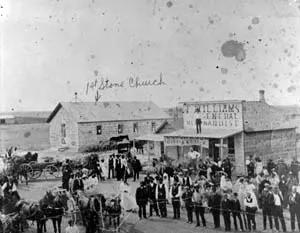From Freedmen, For Freedmen: The Ghost Town of Nicodemus, Kansas
Nestled amidst the vast Kansas prairie, Nicodemus stands as a haunting testament to the dreams and struggles of African Americans seeking freedom and prosperity in the late 19th century. Established in 1877, this small town was founded by a group of ex-slaves and became a symbol of hope and self-determination.
Today, Nicodemus is a ghost town, with a population of just 14 people according to the 2020 US Census. In today's blog, we will delve into the rich history of Nicodemus and explore the factors that led to its eventual decline.
 |
| The townspeople of Nicodemus with "1st Stone Church" labeled by hand. Library of Congress. |
The town of Nicodemus was born during the Reconstruction era, a period when African Americans sought to build new lives for themselves in the aftermath of slavery during the period of Reconstruction after the Civil War. A group of settlers, known as the Nicodemus Town Company, purchased land in Graham County, Kansas, with the vision of creating a self-sufficient community for black families. The promise of free soil and economic opportunity lured them to the heart of the American frontier. The company billed the town, even before its official founding, as "The Largest Colored Colony in America".
In its early years, Nicodemus flourished as a vibrant community. The settlers built homes, established churches, and created a school system. Agriculture played a crucial role in the town's economy, and the fertile Kansas soil yielded crops that sustained the residents. The community became a beacon of hope for African Americans seeking a life free from the shackles of racism and oppression.
 |
| Ad for African Americans to relocate to Nicodemus. Kansas State Historical Society. |
Despite its initial success, Nicodemus faced numerous challenges that contributed to its decline. The harsh Kansas winters, coupled with economic hardships and the lack of essential resources, took a toll on the town. The arrival of the railroad in nearby towns further marginalized Nicodemus, diverting economic opportunities away from the struggling community.
As the 19th century unfolded, the railroad emerged as a symbol of progress, connecting remote towns to the bustling hubs of commerce and trade. For Nicodemus, the prospect of a railway promised economic opportunities, increased connectivity, and a chance to flourish in the evolving American landscape.
This promise never arrived. "Nicodemus township stands ready and willing to vote $16,000 to the first railroad that will come through our town," proclaimed the editor of the Cyclone on April 1, 1888." (Crockett)
 |
| Google Earth image showing the Union Pacific Central Branch which was constructed through Bogue as opposed to Nicodemus, and the Missouri Pacific South Solomon Branch which ended at Stockton, proposed but never built west towards Nicodemus. It is unclear how the Santa Fe would have connected to Nicodemus. |
As many as three railroads, the Union Pacific, Santa Fe and the Missouri Pacific were proposed to run through Nicodemus to serve the town, however, none did, and the fact that multiple companies were considering adding service to the town actually worked towards its disadvantage. While the business owners and townspeople were excited for two or more railroads through the town, the township delayed a bond proposal to the Union Pacific to lay track into Graham County from the southeast. (Crockett) Instead, Bogue would be constructed to be the UP depot, and from there, the road would travel southeasterly towards Damar, bypassing Nicodemus entirely.
Nicodemus, like many small agricultural towns, experienced a decline in population in the early 20th century, and once it became clear that a railroad would not be built to connect the town to the rest of the railroad network, the remaining settlers continued to farm the area, but little in the way of economic development would occur thereafter. By the mid-20th century, the town had become a ghost of its former self, with many of its buildings abandoned and falling into disrepair.
In the 1970s, efforts were made to preserve the history of Nicodemus. The town was designated a National Historic Site in 1996, recognizing its significance as the oldest and only remaining all-black town west of the Mississippi River.
Today, visitors can explore the remnants of Nicodemus, including the Township Hall, St. Francis Hotel, and the African Methodist Episcopal Church.
 |
| Nicodemus Township Hall. Image: Kansas Sampler Foundation |
Nicodemus, Kansas, stands as a poignant reminder of the dreams and struggles of those who sought to carve out a new life on the American frontier, as well as how the fortunes of such a town can live and die by infrastructure investment, in this case, a stop on the railroad (or lack thereof). Its rise and fall tell a story of resilience, community, and the enduring quest for freedom. While the once-thriving town may now be a ghostly echo of its past, the preservation efforts ensure that Nicodemus will forever be a part of America's historical tapestry, inviting visitors to reflect on the challenges faced by its pioneering Freedmen.
For another Kansas town that is still around, but today lacks railroad access, see our blog on Anthony, Kansas: The Town Forgotten by the Railroads.
Thanks as always for reading!



Comments
Post a Comment